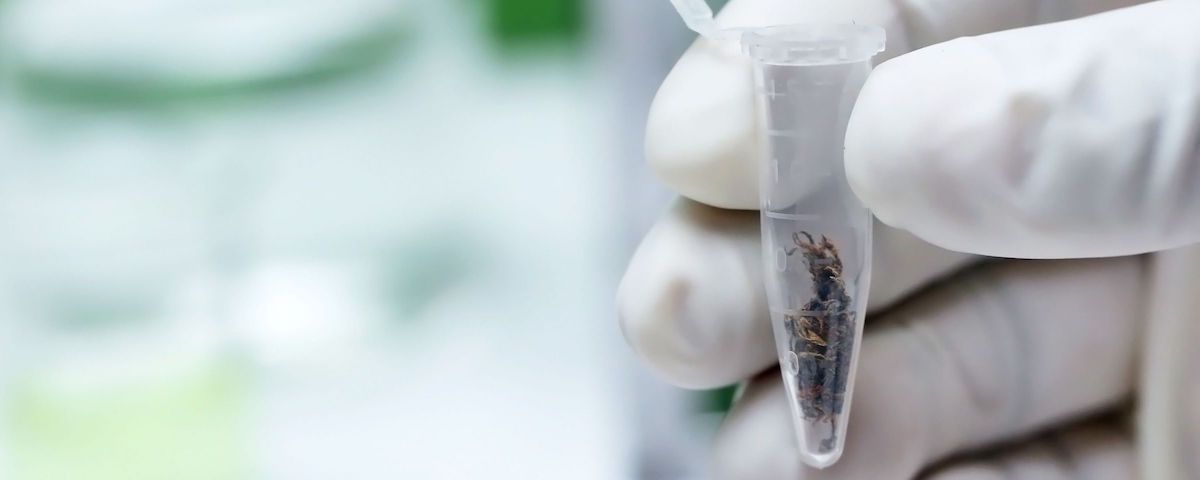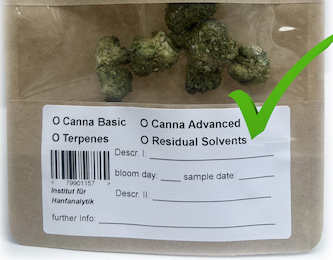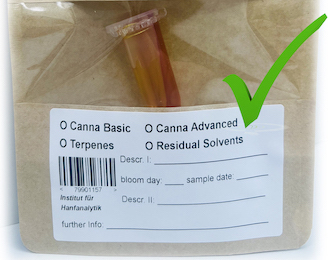

With the Cannabinoid Basic Analysis , we quickly, cost-efficiently, and reliably analyze samples containing only natural cannabinoids (phytocannabinoids) found in plants. (CBD, CBDA, Δ8-THC, Δ9-THC, THCA, CBG, CBGA, CBC, CBN, THCV, CBDV, CBDVA).
Cannabinoid Basic Analysis is the method of choice for plants, extracts, broad and full spectrum oils, resins and distillates.
With the Cannabinoid Advanced Analysis the sample undergoes special preparation procedures. It is then analyzed using several state-of-the-art methods (HPLC-DAD, GC-FID/MS and, if necessary, mass spectrometry). In the process, we quantitatively test the sample for over 20 different natural and synthetic cannabinoids and compare the sample's molecular patterns (mass spectra) with international research databases for well over 10.000 known compounds.
The IFHA's Cannabinoid Advanced Analysis is the most comprehensive analysis for cannabinoids available in Europe and is suitable for all sample materials and all questions. Furthermore, we analyze special sample materials and conversion products exclusively according to the procedures of the Cannabinoid Advanced Analysis..
"Conversion products" are hemp products that contain synthetic cannabinoids such as HHC, H4CBD, THCO, CBND, etc., besides naturally occurring cannabinoids such as CBD, CBG, THC and others. Almost always, the "conversion" of herbal to (semi)-synthetic cannabinoids also results in undesirable by-products, which are then contained in the finished product for sale. For these "conversion products,” we have developed special processing and measuring methods that are applied in the Cannabinoid Advanced Analysis. This way, we ensure the integrity of our measured values and confirm the parameters that are decisive for the legality of a product (e.g., Δ9-THC) with several analytical methods.
"Special sample materials" are samples that require a more complex sample processing due to their ingredients. Cosmetics, edibles, beverages and vape pens need special treatment, such as the separation of polysaccharides and other long-chain molecules, alternative homogenization, residue recovery from cartridges, etc.
In our test procedure, Cannabinoid Advanced Analysis these samples are subjected to a unique, adapted preparation for cannabinoid analysis.



Yes, without exception. This ensures a faster assignment of samples and reduces the risk of mix-ups.
We reserve the right to charge a handling fee of EUR 2.50 for each sample that does not reach us in one of our barcoded transport bags.
Please let us know in advance if one or more of the following ingredients are contained in your sample(s):
To prepare a maximally informative certificate of analysis in our lab, we homogenize the samples; it is, therefore, important that you collect a sample quantity that is as representative as possible of the existing total quantity (e.g. a production batch).
As a registered corporate customer, you will find a letter for the analysis order in your customer portal under Info Material. Please use a separate order letter for each sample and also note the minimum sample quantity, which is indicated on the letter. The processing time is approximately 14 days from sample receipt.
If you have not yet secured your access to the customer portal or are not yet a registered customer, please contact us via e-mail.
After we receive the sample, we will need about 2 to 4 working days for analysis.
Here you can find examples of certificates of analysis:
M.U. is the abbreviation of measurement uncertainty. This parameter describes the statistical dispersion of the values attributed to a measured quantity.
Due to the high concentration in this sample material, the measurement uncertainty also increases to ~5%. The actual value may, therefore, deviate by this percentage in both directions. This is why we cannot reliably provide a more exact value than 98%.
For the calculation of the equivalent sums, the relevant acid forms are multiplied by the factors 0.877 and 0.878, respectively, in order to deduce the corresponding quantity of the neutral form:
Invariably, we do not perform any modifications on certificates of analysis once analysis has been completed. Exceptions are typing errors, transposed numbers, or errors that have, demonstrably, been caused by us.
The percentages refer to the sample that has been sent in. If the sample is representative of a production batch, the percentage distribution of the contents for the complete production batch may be inferred.
After several thousand analyses, we have not yet seen a variety with a higher CBD to THC ratio than 33 : 1.
If there is any doubt about the authenticity of one of our certificates of analysis, please send us the scanned document by e-mail. We will contact you and, if necessary, initiate further steps.
No, any modification, alteration or reproduction, in parts or as a whole, constitutes an act of falsification of documents according to § 223 StGB (Austrian Criminal Code) and will be reported to the respective authorities.
The Institut für Hanfanalytik is a laboratory certified according to ISO 9001:2015. The scope of the certification lies in the spezialisation on drug analysis as well as the testing of hemp, CBD and cannabis products. The respective certificate is available for download here. The process to become an accredited testing laboratory according to ÖVE/ÖNORM ISO/IEC 17025 is still ongoing.
Since we are not subject to any reporting obligation, we will dispose of the sample after analysis has been completed and not retain a sample.
Our terpene profile includes the following terpenes:
Here, we have compiled a detailed overview of the terpenes we are measuring, including a short description.
We need about 5 to 7 working days for terpene analysis.
The first 3 digits of the barcodes on the transport bags are also your customer number.
Of course, in this case we will also make a picture of the outer carton for the certificate of analysis.
This problem is caused by poor cooperation of the used font and our PDF converter. We are working on this problem. In the meantime please install these TrueTimeFonts (Google Link) on your PC to tackle this problem.
As a registered corporate customer, you will find a letter for the analysis order in your customer portal under info material. Please use a separate order letter for each sample and also note the minimum sample quantity stated on the letter. The turnaround time is approximately 10 days from receipt of the sample.
If you have not yet secured your access to the customer portal or are not yet registered, please contact us via info@hanfanalytik.at.
Viral diseases can have a major impact on plant growth and yield. A viral infection reduces the number of trichomes and can halve the cannabinoid and terpene content of a mature plant. Testing for viruses is an important preventative measure to prevent them from spreading in the grow facility.
Leaves, stems and roots are used as samples. We recommend including root samples or older parts of the plant, as this is where pathogens accumulate first and therefore where diseases can be detected earliest. Do not use the same cutting tool for different plants, otherwise there is a risk of contamination.